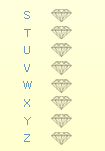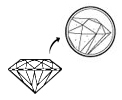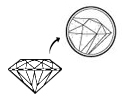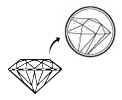Diamonds & Gemstones
You can see the full article by visiting DiamondEmotions.com
Color
Diamonds are found in all colors of the rainbow, from colorless and transparent stones to ink black ones. Varying degrees of yellow or brown color is common in most of the diamonds and slight difference in color can make a substantial difference in value. A truly colorless diamond is extremely rare and considered the most valuable. It allows most light to pass through the stone and create the most brilliance.
During formation of Diamond from carbon, certain chemicals may have been drawn into the mix and results in added tinge of color in the transparent stone.
Most diamonds appear white to the naked eye, but they all include trace amounts of yellow or brown color. The color scale goes from D to Z (no diamond of color grade A, B or C has ever been found), with D being the most white and Z being the most yellow. The best way to see the true color of a diamond is by looking at it against a white surface.
Diamond Color Grade Table
| Color Grade | Description | On Unaided Eye Inspection |
 | Colorless | Stone looks absolutely clear and transparent, with no hint of color. |
 | Near Colorless | Stone looks clear and transparent. Color will be noticeable by experts only when compared to diamonds of better grades. |
 | Faint yellow | Color slightly detectable and will be noticeable by experts only. |
 | Very Light yellow | Stone shows an increasing yellow tint, even to an untrained eye. |
 | Light yellow | Stone appears yellow, even to an untrained eye. |
 | Fancy | Bright, remarkable color – usually blue, pink, yellow, Red etc. |
Fancy Colored Diamonds
Although majority of diamonds come in shades of white, there are also “Fancy” natural intensely colored diamonds available in colors like yellow, pink, greens, brown, red, orange, blue etc. These intensely colored diamonds are very rare, attractive and desirable. A deeply colored diamond can cost more than its colorless counterpart. These intensely colored diamonds are known as “Fancy” colored or “Fancies”. Fancy colored diamonds are graded in two ways. The first factor is the basic hue, such as pink, yellow, blue, green, etc. The second is the intensity. Both color characteristics form the basis for determining a fancy colored diamond”s worth. In fancy colored diamonds, Z+ grade is used for their color grading. Usually, the more intense the color, the rarer and more expensive the diamond will be. For example, a fancy light pink diamond costs less than a fancy vivid pink diamond of equal size, shape and clarity. Though fancy colored diamonds rarely occur in nature, laboratories can easily create them through irradiation and heating. This process can permanently turn a natural colorless diamond into a fancy colored diamond. Treatments have also been developed to make lower-color white diamonds whiter. Irradiated colored diamonds have a significantly lower value than natural fancy diamonds and can be detected in a gem laboratory.
Fluorescent Diamonds
Fluorescence is a form of illumination that is created when a diamond is exposed to low or high wave ultraviolet radiation. Fluorescence up to some extent is common in majority of diamonds. Faint or medium fluorescence will rarely affect a diamond”s appearance. Usually fluorescence remains unnoticed by human eyes in ordinary light.
Clarity
Clarity is a term used to describe the absence or presence of flaws inside or on the surface of a diamond. In other words, the clarity of a diamond refers to a diamond”s clearness or purity.
When these flaws / marks occur internally, they are called inclusions and the most common types of inclusions include Crystals, Tiny Bubbles representing small minerals that were absorbed into the diamond while it was growing, Internal Graining, Needles, Knots, Chips, Cavities, Cleavage, Feathers, and Clouds. On the contrary, when these flaws / marks occur on the surface, they are known as blemishes and the most common types of blemishes include Polish lines, Naturals, Scratches, Nicks, Pits, transparent stress lines that appear on a diamond”s surface, surface graining, and extra facets, that are usually cut to remove a near-surface inclusion to raise the clarity grade of a stone. Most diamonds have these imperfections in them. Although many of these flaws are not visible to the naked eye, but under magnification, tiny featherlike shapes, crystals, bubbles and dark flecks become noticeable. These slight flaws make every diamond quite unique but they also do affect the beauty and value of the diamond.
Diamond”s clarity is based on the number, size, nature, and location of imperfections on the finished stone. Diamond with higher clarity is more valuable in comparison to diamond that contains numerous inclusions because it is less brilliant due to inclusions interfering with light passing through it.
Diamond Clarity Grading Scale Table
| Image | Clarity Grade Scale | Description | On Inspection through 10x magnification |
 | F | Flawless | Clear Stone, no inclusions or blemishes. Exceptional and beautiful diamonds. |
 | IF | Internally Flawless | No inclusions and only insignificant surface blemishes. Rare and beautiful diamonds. |
 | VVS1 – VVS2 | Very, Very Slightly Included – 1 & 2 | Tiny inclusions, which are extremely difficult to find, even under 10x magnifications. An excellent quality diamond. |
 | VS1 – VS2 | Very Slightly Included – 1 & 2 | Minor inclusions, which are difficult to see under 10 x magnification. These stones are less expensive than the VVS1 or VVS2 grades. |
 | SI1 – SI2 | Slightly Included – 1 & 2 | Inclusions, which are easy to see under 10 x magnification. A good diamond value. |
 | I1 – I2 – I3 | Included – 1, 2 & 3 | Inclusions, which are easy to see under 10 x magnification and sometimes, may be visible with the unaided eye. A good diamond value. Generally I3 grade is not used for jewelry purposes and mostly used in industrial applications. |

